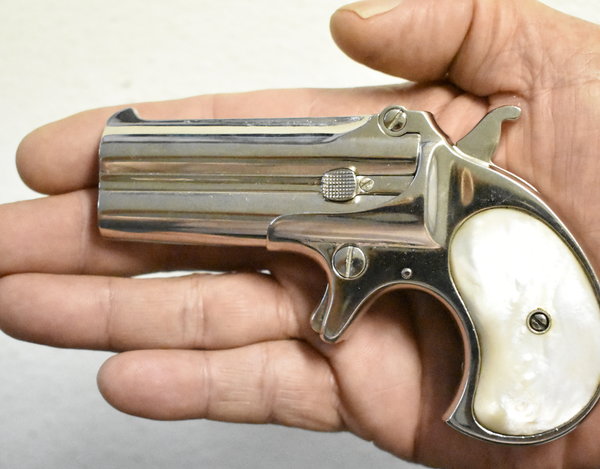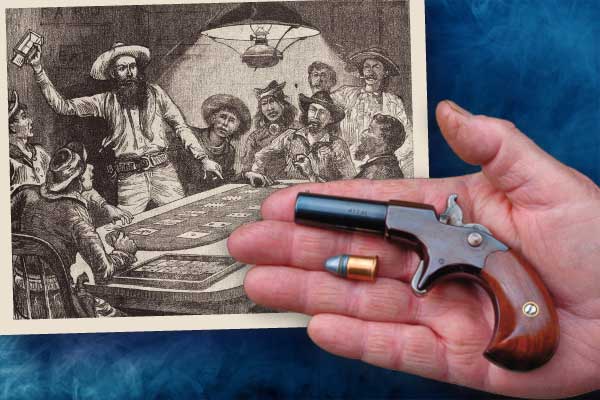- Joined
- Jan 21, 2009
- Messages
- 65,981
- Reaction score
- 23,408
- Gender
- Male
- Political Leaning
- Undisclosed
Caveat: This does not apply to home defense, professional carry or carrying in any situation I anticipate potential danger. For those it is 12 gauge shotguns, 45acp and 30-06 or .308.
Why in my personal activities I now usually carry very low firepower antique pocket guns– and just went smaller...
The passing years and a more sedimentary lifestyle take their toll on physical fighting ability. At one time in the increasingly distant past, there were few people on this planet who could win an unarmed fight with me. But I recognize increasingly I am slower, weaker, less flexible, less focused and less wired for a physical fight. In short, increasingly vulnerable and less able to defend others.
Yet I also recognized I truly don't want to kill anyone unless a true necessity. Simply, I do not subscribe to the rule of always shoot-to-kill. Added to this is my opinion that merely displaying having a firearm will defuse nearly any situation – while also recognizing the instant legal jeopardy the moment you display a firearm. Merely displaying having a firearm to frighten someone off is a felony unless you can prove valid reason for doing so as an affirmative defense. Among other things, this concern can lead to fatal hesitation.
Simply, my goal of routine personal low-risk situation carry is:
1. Minimize legal jeopardy – both having the gun and displaying the gun
2. To SUPPLEMENT my declining physical fighting ability.
3. To literally be able to have a gun in my hand without legal jeopardy.
From my past experiences and what is known, an assailant(s) doesn't give warning. A violent attack often will come with no warning whatsoever and happen incredibly fast – though usually you can sense a dangerous person or setting. What this means in real terms is you would not have time to go for a CCW. In addition, if someone already has a gun on me, I certainly would not try to quick-draw. In short, with any sensing of danger I want the gun in my hand, not pocket or holster.
That means “antique”gun in this state. In Florida, an antique gun is exempt from all gun laws UNLESS the gun is used to commit a crime. While this specifically applied to antique cap-and-ball (and flintlock), it also applies to any firearm made before 1918 that ammo is not manufactured for (the ammo rule bars basically all semi-autos, .22s, .25s etc).

I saw this at a flea market a couple weeks ago. Wasn't looking for anything like this, but at this condition and for the price? It was a steal. It is an as-new 1889 to 1893 no-serial number (only “batch” number) Remington .41 rimfire super short derringer with a full box of black powder live nickle casings and copper coated vintage cartridge ammo (SUPER rare).Although a .41, being a super short it is very low firepower – only 100 pounds ft-lbs at 600 ft/sec. Enough to penetrate. Nothing more.For comparison, a 9mm FMJ comes in at 350 to 400 ft-lbs – 350-400%more impact power.
So why such a low firepower pocket gun?
1. Other than aircraft, courthouses or other places they metal scan, it can be legally taken anywhere guns are prohibited - and is completely a “non-firearm” under Florida state law, particularly since it fires ammo that hasn't been made in decades.
2. It is a gun – with all the fear-factors of it. Only a lunatic would see twin 41 caliber barrels and not back off.
3. I can have it in my hand at a sense of danger – small enough so no one sees it unless I want the person to (I have big hands).
4. It is to supplement my declining fighting ability. Shooting someone with it is unlikely to be a kill-shot. But even if not chasing the person off it will reduce their fighting ability and is a huge distraction. (Most fights I was in were decided in the first few seconds because I know how to strike a person in disability ways).
5. I really don't want to kill anyone. Very much so.
6. It's really cool, I like these old all-steel guns. They have a good, solid feel.
Why in my personal activities I now usually carry very low firepower antique pocket guns– and just went smaller...
The passing years and a more sedimentary lifestyle take their toll on physical fighting ability. At one time in the increasingly distant past, there were few people on this planet who could win an unarmed fight with me. But I recognize increasingly I am slower, weaker, less flexible, less focused and less wired for a physical fight. In short, increasingly vulnerable and less able to defend others.
Yet I also recognized I truly don't want to kill anyone unless a true necessity. Simply, I do not subscribe to the rule of always shoot-to-kill. Added to this is my opinion that merely displaying having a firearm will defuse nearly any situation – while also recognizing the instant legal jeopardy the moment you display a firearm. Merely displaying having a firearm to frighten someone off is a felony unless you can prove valid reason for doing so as an affirmative defense. Among other things, this concern can lead to fatal hesitation.
Simply, my goal of routine personal low-risk situation carry is:
1. Minimize legal jeopardy – both having the gun and displaying the gun
2. To SUPPLEMENT my declining physical fighting ability.
3. To literally be able to have a gun in my hand without legal jeopardy.
From my past experiences and what is known, an assailant(s) doesn't give warning. A violent attack often will come with no warning whatsoever and happen incredibly fast – though usually you can sense a dangerous person or setting. What this means in real terms is you would not have time to go for a CCW. In addition, if someone already has a gun on me, I certainly would not try to quick-draw. In short, with any sensing of danger I want the gun in my hand, not pocket or holster.
That means “antique”gun in this state. In Florida, an antique gun is exempt from all gun laws UNLESS the gun is used to commit a crime. While this specifically applied to antique cap-and-ball (and flintlock), it also applies to any firearm made before 1918 that ammo is not manufactured for (the ammo rule bars basically all semi-autos, .22s, .25s etc).
I saw this at a flea market a couple weeks ago. Wasn't looking for anything like this, but at this condition and for the price? It was a steal. It is an as-new 1889 to 1893 no-serial number (only “batch” number) Remington .41 rimfire super short derringer with a full box of black powder live nickle casings and copper coated vintage cartridge ammo (SUPER rare).Although a .41, being a super short it is very low firepower – only 100 pounds ft-lbs at 600 ft/sec. Enough to penetrate. Nothing more.For comparison, a 9mm FMJ comes in at 350 to 400 ft-lbs – 350-400%more impact power.
So why such a low firepower pocket gun?
1. Other than aircraft, courthouses or other places they metal scan, it can be legally taken anywhere guns are prohibited - and is completely a “non-firearm” under Florida state law, particularly since it fires ammo that hasn't been made in decades.
2. It is a gun – with all the fear-factors of it. Only a lunatic would see twin 41 caliber barrels and not back off.
3. I can have it in my hand at a sense of danger – small enough so no one sees it unless I want the person to (I have big hands).
4. It is to supplement my declining fighting ability. Shooting someone with it is unlikely to be a kill-shot. But even if not chasing the person off it will reduce their fighting ability and is a huge distraction. (Most fights I was in were decided in the first few seconds because I know how to strike a person in disability ways).
5. I really don't want to kill anyone. Very much so.
6. It's really cool, I like these old all-steel guns. They have a good, solid feel.



